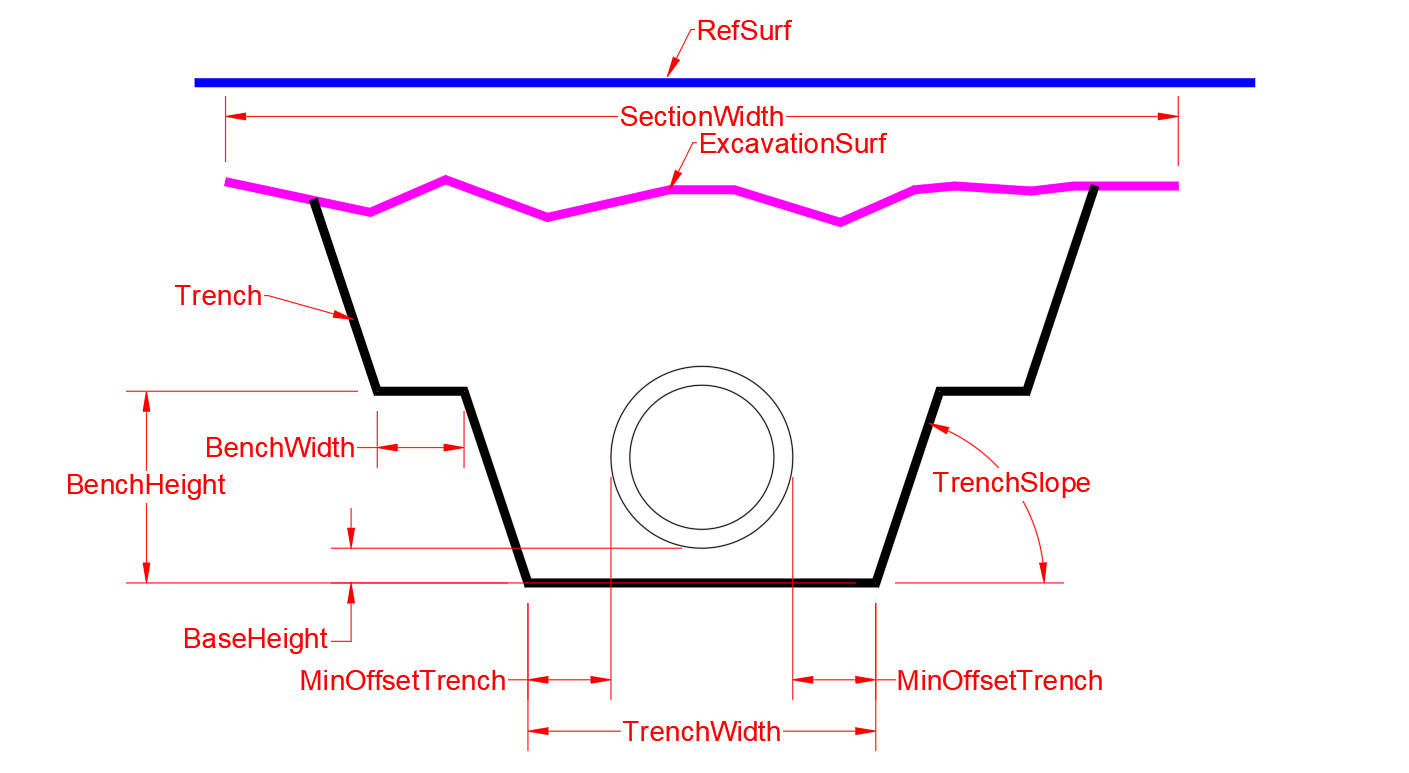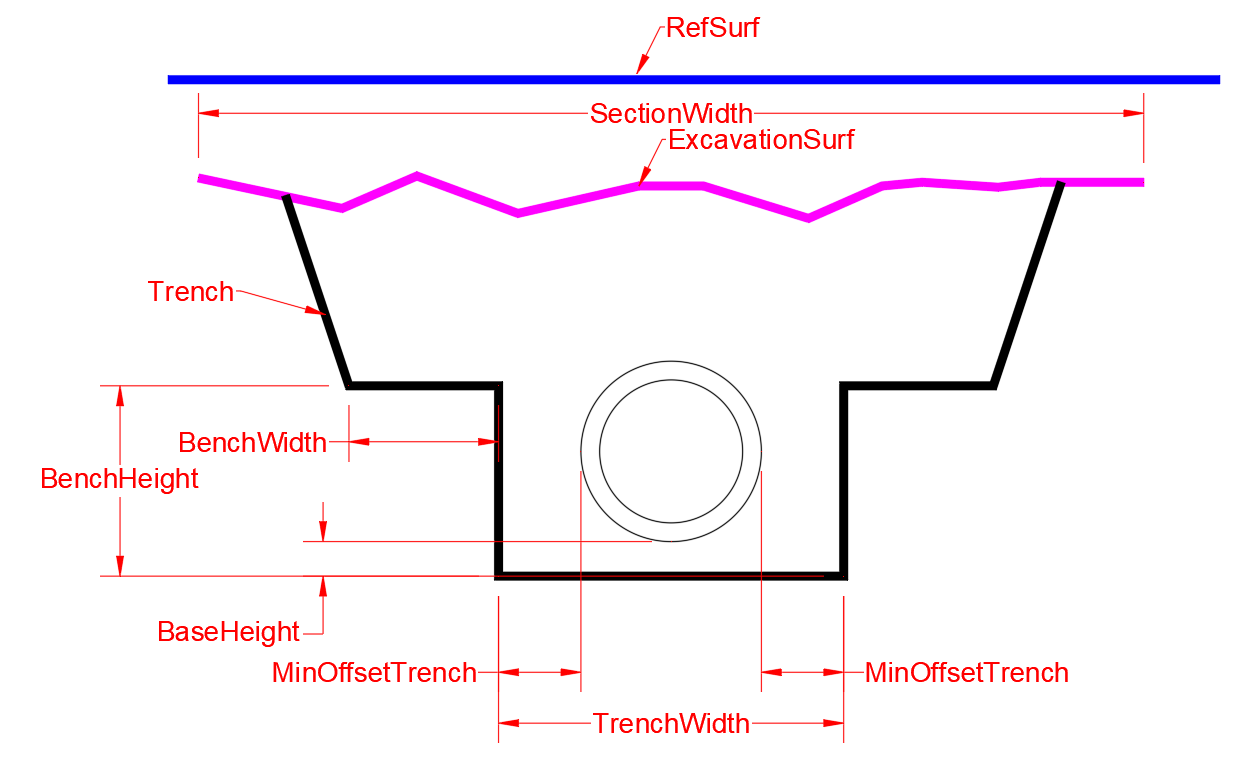Options - Excavation
The excavation category controls how the devices excavation calculations are done, establishing limits, minimum dimensions, or type of excavated section.
Configure the values of the properties below according to the guidelines of NBR 9061/1985-open pit excavation safety
The properties of the Excavation category are:
- CalculateExcavation, Boolean - Indicates whether or not the excavation calculation engine is enabled throughout the project
- Stool (BenchWidth, Double) - in very deep trenches, you should excavate the trench creating stools in order to prevent slipping
This value is the width of this bench. As it is a temporary excavation and will be filled up later, slopes are not considered for these benches
- Distance on Arcs (SectionArcDistance, Double) - Distance between sections on arched sections
In longitudinal devices, when the vertices are rounded, the distance between earthwork sections can be reduced, producing a better result
- Distance between Sections (SectionDistance, Double) - to quantify excavation volumes in linear devices, a sampled section of the trench is evaluated at each distance interval.
This is the adopted value.
Think of it as modeling a civil 3D corridor for pipes, you could consider something like 5 meters
- Minimum shoring (MinShoring, Double) - It is the cutting height of the ditch from which the shoring of the ditch walls is mandatory
For the purpose of calculating the score, the following criteria are adopted:
- If the Ditch Depth ≤ Minimum depth, then Shoring = 0
- If the Ditch Depth ≤ Bench Height
- If Ditch slope ≥ 80 degrees, then Shoring = Ditch depth
- If Ditch slope < 80 degrees, so Shoring = 0
- If the Ditch Depth ≥ Bench Height
- If Ditch slope ≥ 80 degrees, then Shoring = Bench Height
- If Ditch slope < 80 degrees, so Shoring = 0
- Section Width (SectionWidth, Double) - It is the width of the cross section to search for the terrain line
Limit to values compatible with the width of the excavation, as this is an item that can take time to calculate
For circular pipes, trenches are not larger than 10 meters.
So this looks like a good value
- Minimum Offset (MinOffsetTrench, Double) - Minimum distance between the projection of the external wall of the device and the wall of the trench, which allows circulation during the laying of the device
- Maximum Slope (BenchHeight, Double) - Maximum height of the trench from which a bench must be dug
- Ditch Slope (TrenchSlope, Double) - angle of inclination of the trench slope
- Trench Type (TrenchType, Enumerator) - Controls the type of trench excavated, it can be:
- Standard - trapezoidal trench, with banks defined using the maximum height of the slope, width of the bank and slope of this slope

- Square - rectangular ditch with a height equal to the maximum height of the slope, from which a bench is excavated and from there follows with the slope of the configured slope

- Height of the Berth (BaseHeight, Double) - height needed to build the berth in lean concrete, gravel or just leveling the bottom of the ditch
- Minimum Trench (MinTrenchWidth, Double) - Small devices, such as DN40 pipes, the trench tends to be narrow.
For small depths, where even shoring is dispensed with, the minimum trench width must be respected, so if the external width of the device plus the minimum offset is less than the minimum trench, this will be adopted.
Take it to be the width of the bucket of the machine that digs the trench
- Trench Width (TrenchWidth, Double) - A default value for trench width when creating new typical sections in the material list
- TrenchLength (TrenchLength, Double) - A default value for the trench length when creating new typical point device sections in the material list
- Fix Ditch(FixLengthWidth, Boolean) - Indicates that the width of the ditch will always be fixed. If it is disabled, the correction is only made if the arbitrated value is smaller than the external width of the device plus twice the Minimum Offset
- Number of Divisions (DivCount, Integer) - Number of sections per side to be calculated for point devices
 Note: With the exception of the Calculate Excavation property, these properties only affect new fixtures and new typical sections.
Note: With the exception of the Calculate Excavation property, these properties only affect new fixtures and new typical sections.

